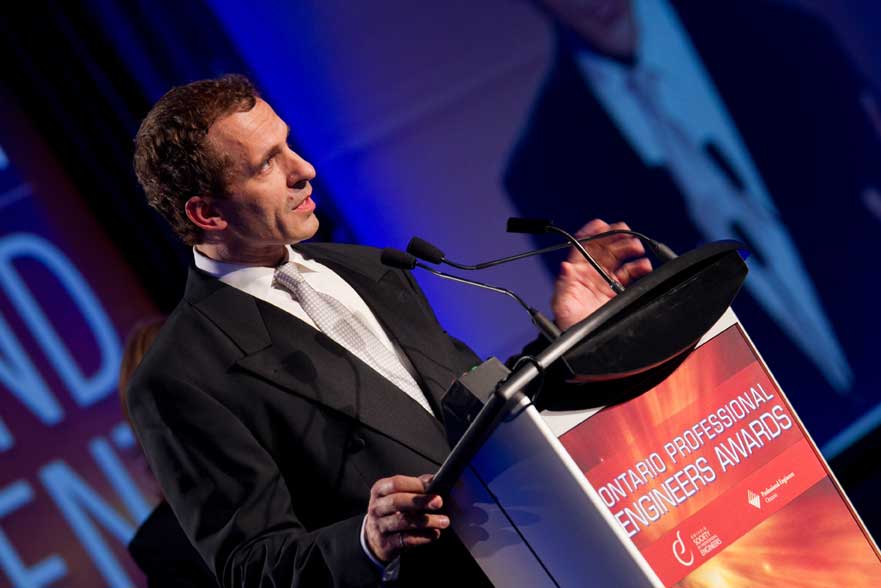Professor Doug Perovic, an expert in materials forensics, weighs in on recent structural failure incidents in Toronto

Photo: Professor Doug Perovic at the 2011 Ontario Professional Engineers Awards Gala where he received the Engineering Medal for Research & Development
August 23, 2012
Chunks of concrete tumble from the Gardiner Expressway, the Algo Centre Mall collapses in Elliot Lake, shards of glass fall from Toronto condos, and a Radiohead stage gives way at Downsview Park.
Just how safe are the structures that we build?
“Nature always looks for ways to use energy in a favourable state – gravity always pushing things downwards is an example,” says materials science and engineering professor Doug Perovic. “Any built structure naturally goes against nature. Therefore, all structures will eventually be broken or destroyed – given the right amount of time, they will break down or fail.”
In mid-July, pieces of concrete fell off the Gardiner Expressway onto Bathurst Street in Toronto. And in late June, a car was struck by a falling piece of concrete.
The Gardiner was designed in the 1950s and built in the 60s; at the time road salt was not used to prevent sliding and crashes during winters, says civil engineering professor Doug Hooton.
“They didn’t design [the Gardiner] to resist salt – they didn’t realize it would be exposed to salt,” says Hooton, an NSERC/Cement Association of Canada Industrial Research Chair in concrete durability & sustainability. “And so, they only put a small amount of concrete over the steel structure.”
As the road salt seeps into the concrete over the years it will eventually rust the steel structure of the elevated expressway.
“The rust causes the steel to become larger and puts the surrounding concrete in tension,” explains Hooton. “Then the outer layer of concrete gets cracked and pushed off.”
Hooton believes Toronto’s recently unveiled 10-year plan to replace the concrete on the Gardiner is the best approach to the situation. The plan calls for the installation of concrete that is an appropriate thickness and a waterproofing membrane to prevent rust.
“They’ll do all the good things that will make the Gardiner last longer,” says Hooton.
Hooton and Perovic point to parallels between the troubles of the expressway and the collapsed mall in Elliot Lake. Because the mall’s roof had acted as a parking garage, road salt had the opportunity to seep into the concrete, causing the steel to deteriorate.
“Again, it’s basically rusty steel – salt gone through the roof because they didn’t waterproof it,” explains Hooton. “However, what collapsed was the actual steel frame, not just the concrete like on the Gardiner.”
“The scene has been completely sealed off by the police,” said Perovic, who was part of a team that traveled to Elliot Lake to investigate the collapse, only to have the work called off by authorities after the structure was deemed too unstable.
“Not much is known in detail.”
Falling condominium glass has been another concern in the minds of Torontonians. However, Perovic believes pedestrians need not walk in fear.
The type of glass which has been shattering is tempered glass, which is about five times sturdier than regular glass and has been efficiently used for 50 years, he says.
“The reason we’re seeing all these failures at one time basically comes down to bad batches of glass with too much impurity,” says Perovic. “A number of those buildings built last summer were from the same developer, so they’re probably getting the glass from the same manufacturer.”
Perovic, who has analyzed pieces of the shattered glass, believes nickel sulphide particles in the glass (emanating from raw material of low quality) are to blame for the incidents. Nickel sulphide particles expand rapidly with heat, as the particles expand they shatter the glass from within.
“It only takes a small amount of nickel sulphide to ruin a lot of glass,” says Perovic.
The incidents aren’t attributed to how the windows were installed or how they may have been damaged – it’s a built-in stress in the glass.
Both professors agree that Toronto remains a structurally sound and safe city. However, the collapse of the Downsview Park stage remains an unsolved mystery.
Perovic has spent a lot of time analyzing the Radiohead stage, which collapsed in mid-June. He is currently working with teams examining the material to determine the quality of the structure.
“The first thing you would guess is that maybe [the stage] was overloaded,” says Perovic who could not comment in detail about the ongoing investigation.
“Another possibility is that the stage wasn’t assembled properly: maybe a joint or weld was improperly attached. Then with a lot of weight on top, a sequence of events ensues so the next part gets overloaded and then you get this progressive collapse.
“There may be many possible causes, or it may just be a simple one,” says Perovic. “We don’t know yet. Those answers will be coming in the near future.”
— With files from U of T Office of Strategic Communications & Marketing